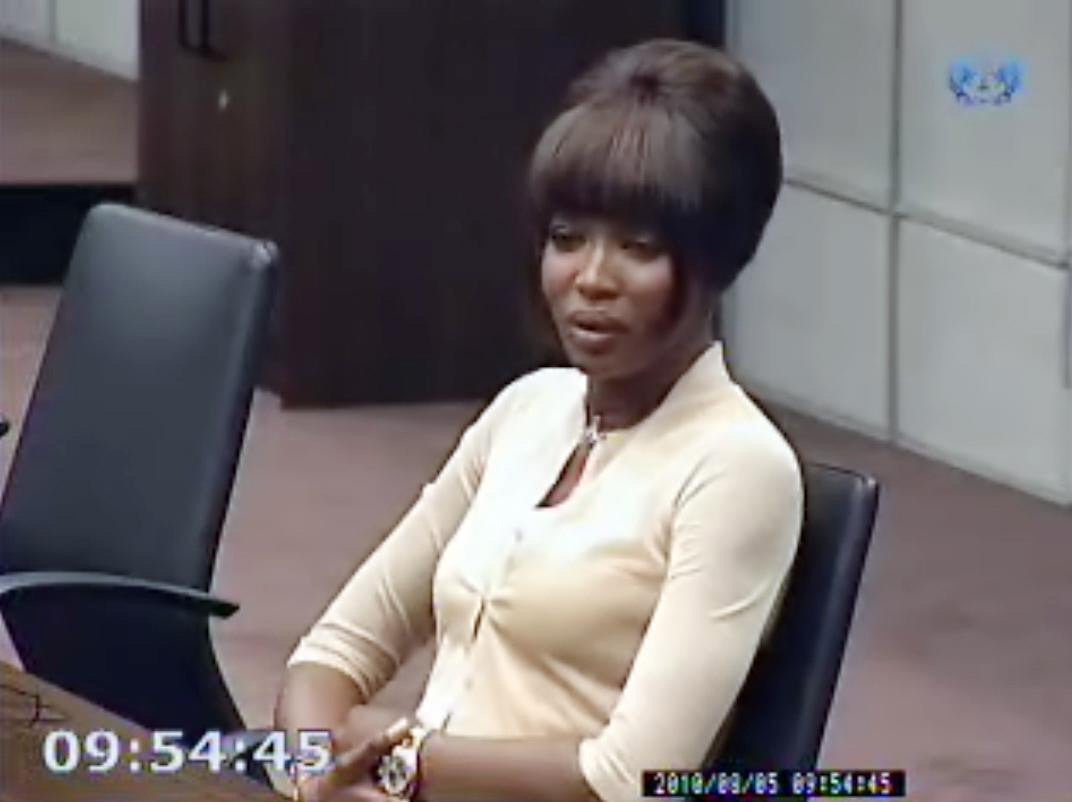From supermodel to supermum: How Naomi Campbell conquered the world
As the new mother turns 51, Rupert Hawksley explores Campbell’s lifelong conflict between publicity and privacy through the highs and lows of her remarkable career


In March last year, Naomi Campbell boarded a flight from Los Angeles International Airport wearing a white hazmat suit, goggles, blue mask and pink latex gloves. Draped over her shoulders was a $3,000 Burberry cashmere cape. The images, posted on the British supermodel’s official Instagram page, were “liked” by more than half a million people, while the “look” is now on display at the Fashion Museum in Bath.
It is a neat metaphor for Campbell’s life – she wants to protect herself, to keep the world at bay, but she is also one of the most recognisable faces on the planet. As U2 frontman Bono, a close friend of Campbell’s, once said, she has a body “handmade by God”. Or to put it another way, Naomi Campbell in a hazmat suit is still Naomi Campbell.
There is no vaccination against her level of fame; all she can do is try to control it. This, perhaps, is why she enjoys the anonymity of flying so much. “I love being everywhere and nowhere at the same time,” she said in 2019.
We saw this conflict between the private and the public play out again last week when Campbell announced that she had become a mother for the first time at the age of 50. On Tuesday, Campbell posted a picture to her 10.5 million Instagram followers of her daughter’s feet, cupped in her right hand, alongside the caption: “A beautiful little blessing has chosen me to be her mother [...] There is no greater love.”
It is the only information we have been given. We don’t yet know the name of the baby, when she was born, the identity of the father, or whether Campbell used a surrogate. She has, if you like, retreated into her hazmat suit – prepared to engage with the public, but on her own terms, before sealing herself and her daughter away.
Only the most rarefied group is granted access to Campbell. The editor of British Vogue, Edward Enninful, messaged: “Seeing the two of you together made my year. You will bring each other so much joy.” American designer Marc Jacobs was quick to offer his congratulations, too, not forgetting to let the world know that he, of course, had been in on the secret all along: “Oh my God!!!! Today is the day?? How absolutely incredible.”

This might be Campbell’s first child, but in recent years she has taken on something of a maternal role in the fashion industry. Younger models look to Campbell, who started modelling in 1986, for advice and inspiration. Ugbad Abdi, who was born in Somalia and raised in a Kenyan refugee camp, told Vogue last year: “I wouldn’t be here if it wasn’t for [Campbell] being who she is unapologetically. She is the blueprint.” Austrian designer Kenneth Ize added: “She knows the value of what she is bringing to the table, and that if she supports this brand it’s going to hit the next level. Naomi is an activist – she tries to make sure that everyone is OK.”
Outside the world of fashion, young people have also embraced Campbell, both as an uncompromising “queen” and as a genuinely positive influence. Her sassy one-liners – she once told Australian model Nicole Trunfio, “Don’t compare yourself to me... ever!” – have inspired countless memes, while Generation Z refers to her as “aunty”.
(I am not, alas, Gen Z but I do have a favourite Naomi moment. When she was called to testify in The Hague during the war crimes trial of former Liberian president Charles Taylor, from whom she had allegedly received blood diamonds in 1997, Campbell took to the stand and announced: “Well, I didn’t really want to be here, so I was made to be here. So obviously I’m just, like, wanting to get this over with and get on with my life. This is a big inconvenience for me.” Exactly the behaviour we want from our supermodels.)
Meanwhile, Campbell’s “No Filter with Naomi” series on YouTube, where she has interviewed Stacey Abrams, Pharrell Williams and Gwyneth Paltrow, is watched by tens of thousands of people every week. It’s hard to imagine they all have a subscription to Vogue.
One comment on a viral YouTube video Campbell posted of herself, which shows her obsessively cleaning the surfaces around her aeroplane seat, perhaps best sums up her newfound position in the public eye: “She gives me the feeling of a wholesome caring mum, so gentle and kind.” It is a role Campbell clearly adores. In an interview with The Guardian last year, she said: “I don’t feel old. Even when I was called ‘aunty’ 10 years ago. I’ve never felt old. I find them sweet!”
I wouldn’t be here if it wasn’t for [Campbell] being who she is unapologetically. She is the blueprint
For those who witnessed Campbell’s rise to the pinnacle of fashion in the 1990s and 2000s – she was one of the “big six” supermodels from that era, alongside Cindy Crawford, Christy Turlington, Linda Evangelista, Claudia Schiffer and Kate Moss – this more caring, maternal side might well come as a surprise. It was not, to put it mildly, always like this. Particularly if you worked for Campbell.
Between 1998 and 2009, Campbell was accused of 11 acts of violence, including by her former PA, Vanessa Frisbee, who alleged that the supermodel threw a plate at her in 2000, and by a former maid, Millicent Burton, who claims that she was slapped by Campbell in 2004. (A year later, Campbell appeared in public wearing a T-shirt emblazoned with the words, “Naomi hit me… and I loved it”.) In 2008, Campbell was banned from flying with British Airways after she allegedly spat in the face of a police officer who had been called after a scuffle broke out at Heathrow when Campbell was informed her luggage had gone missing.

Campbell’s most notorious tantrum occurred in 2006, however, when she threw a mobile phone (not a diamond-encrusted BlackBerry, as was widely reported) at one of her employees, Ana Scolavino, in a Manhattan apartment, apparently after a row about a pair of jeans. Campbell later said the row wasn’t about a pair of jeans but was unable to remember the details, which makes me suspect it was about something even more trivial. She was ordered to pay damages and served five days of community service at a New York City sanitation garage (ever the professional, Campbell arrived on day one in a Giuliana Teso fur coat).
It is easy to laugh at these stories of a hard-partying, high-maintenance supermodel (literally) throwing her toys out the pram. But we should be cautious, not least because Campbell attributes a lot of the negative coverage to racism. In an interview last year with Harper’s Bazaar, she said: “Oh my God, [the angry Black woman label] has been used against me many times. I said to someone yesterday that it’s been applied towards me so much and what for – to silence me? Well, here I am.”
It is also worth remembering that Campbell, who has never met her father after he walked away from Campbell’s mother when she was pregnant, was thrust into the public eye at a remarkably young age.
She was spotted by a model scout in Covent Garden when she was 15, and appeared on the cover of British Elle before her 16th birthday. From there, her career took off. She has appeared on more than 500 magazine covers, including 66 for Vogue worldwide (she was the first Black model to appear on the cover of French Vogue), and has walked the runway for every designer you care to name. There are books and films and perfume ranges, all propped up on her name – Naomi.

But, as so often with those who achieve early fame, there is a price to be paid. Treatment for cocaine and alcohol addiction, as well as those high-profile accusations of violence, suggest that there was a prolonged period when Campbell’s life was coming undone at its very expensive seams.
In 2010, in a heartfelt interview with Oprah Winfrey, Campbell explained that she realised she had a cocaine problem when, in 1997, she started using the drug to relieve the trauma of losing so many friends, including Gianni Versace, who died that year. “I couldn’t keep up with the grief, so I just started replacing it with drugs,” she explains. In 1999, she went into rehab.
Watching this interview over a decade later, it is striking how brittle and frightened Campbell still appears, even though, by this point in her life, many of her demons were very much in the rear-view mirror. “It’s a fear issue,” she says when asked about her outbursts, “because anger comes from fear.” She then talks of having an “abandonment issue” and “trying to build up a family around me that’s not my immediate family and if I feel mistrust, then all my cards go down”.
And so we return to the conflict for Campbell between the private and the public; her fear of letting people in. That erratic behaviour in the 1990s and 2000s, the drugs, the booze – weren’t these, like her discretion now, just a hazmat suit for her emotions? And can’t we forgive her for that?
Eleven years on from that interview, Naomi Campbell has redefined herself again. “I’m bossy and motherly,” she said in an interview last year. Yes, she has earned her wisdom the hard way and, on her 51st birthday, is still the greatest supermodel on the planet. She’ll be a great mum, too.


Join our commenting forum
Join thought-provoking conversations, follow other Independent readers and see their replies
Comments